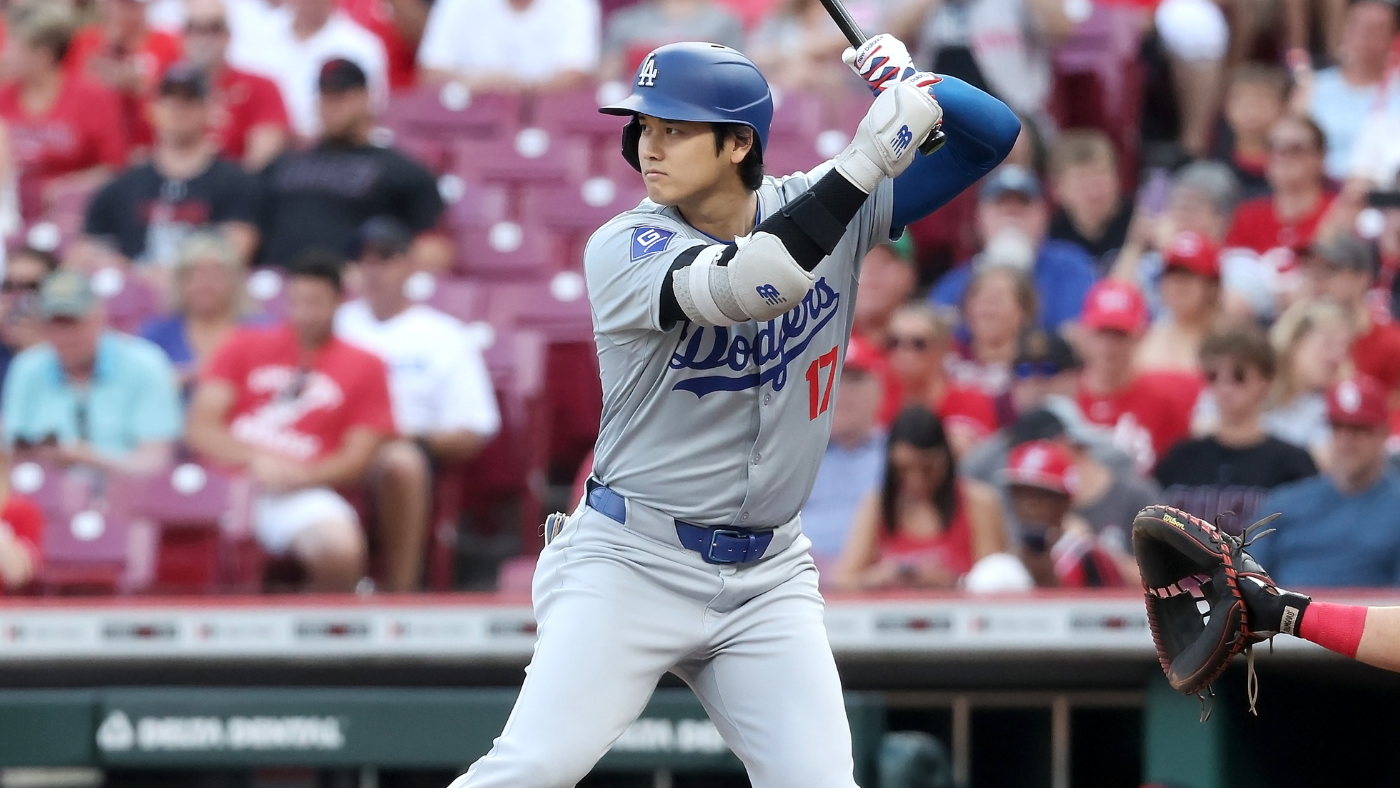Baseball’s two-way players: From Babe Ruth to Shohei Ohtani and 2024 potential draftees like Jac Caglianone
Written by CBS SPORTS ALL RIGHTS RESERVED on July 9, 2024


This year’s edition of Major League Baseball’s amateur draft will begin on Sunday, July 14. The Cleveland Guardians will make the No. 1 selection for the first time in franchise history, having won the lottery last winter despite holding just a 2% chance entering the process. The Guardians have previously selected No. 2 on five occasions, most recently in 1992 when they chose fireballing right-hander Paul Shuey from the University of North Carolina.
While it’s anyone’s guess as to who the Guardians will pick, arguably the most intriguing player in this year’s class is Jac Caglianone, a first baseman and left-handed pitcher at the University of Florida. Caglianone combines prodigious strength at the plate (he homered 62 times the last two seasons) with an upper-90s fastball on the mound (he struck out 155 batters in 136 career innings). He’s considered to be one of the top prospects in this class.
It’s to be seen if Caglianone will be afforded the opportunity to play both ways as a professional. But that possibility inspired us here at CBS Sports to take a deep dive into MLB’s history with two-way players. Below you’ll find an abbreviated version of that history, ranging from Doc White to Shohei Ohtani and beyond, as presented across 10 distinct “eras” — these are used for storytelling and formatting purposes, and shouldn’t be taken as anything more than arbitrary measures.
With the fine print out of the way, let’s get to it.
1. The early days
It should come as no surprise that two-way players were at their greatest prevalence before the turn of the 20th century. Rosters were smaller, not reaching their familiar 25-player limit until closer to World War I. Pitchers worked in a rotation and were often tasked with throwing complete games when their turn came. Many took to other positions on their scheduled days off, including Jack Stivetta, Kid Gleason, Win Mercer, and Amos Rusie. Two-way players became less commonplace in the early parts of the 1900s. Whereas there were 62 individual seasons before 1900 that saw a player pitch 15 or more times and record 200 plate appearances, there were 13 from 1900-1910. (There’ve been 20 total since.) Doc White was perhaps the best known of those holdouts, though his best work often came on the mound (like when he won the 1906 ERA title). Others, such as Jack Coombs and Zaza Harvey, also turned in quality seasons while splitting their time on and off the mound.
2. The Babe
Babe Ruth, to this day the most famous two-way player in the sport’s history, arrived in 1914. For all the emphasis placed on his two-way talents, there wasn’t much overlapping brilliance. His first season as a regular hitter, 1918, served as his penultimate campaign as a regular pitcher. Ruth was accomplished at both aspects of the game. He won the 1916 ERA title and finished his career with a 122 ERA+ as a pitcher; as a hitter, he led in home runs a dozen times and posted a 206 OPS+. Many of Ruth’s contemporaries would follow a similar career arc: arriving as pitchers, then transitioning to full-time positional play. A few, like Doc Crandall and Hall of Famer George Sisler, had seasons where they played both ways. Ruth, though, was the last true two-way player in either the American or the National League for some time to come.
3. The Negro Leagues
The two-way player might’ve disappeared from the MLB landscape by the beginning of the Live Ball Era (defined as 1920 onward), but it remained ever-present in the Negro Leagues. Be it Leon Day or Cuban-born Martín Dihigo, once described by Hall of Famer Johnny Mize as “the only guy I ever saw who could play all nine positions, manage, run, and switch-hit.” From Ted “Double Duty” Radcliffe, who bore an appropriate nickname, with legend having it that he once caught the first half of a doubleheader before pitching the second, to Bullet Rogan, who allegedly threw harder than Satchel Paige, and was labeled the best all-around player in the world by Casey Stengel. And so on. The two-way player was a fixture in the various Negro Leagues, which remain responsible for 17 of the 23 most recently recorded two-way seasons (min. 10 games pitched, 200 plate appearances).
4. A wartime outlier
Nearly three decades would pass between Ruth’s transformation into a full-time hitter and the return of the two-way player to the American or National League. In 1945, during the waning days of World War II, Cuban national René Monteagudo served as a pinch-hitter and mop-up reliever for the hapless Philadelphia Phillies. He would appear in 114 games as a batter, starting just 30 of them, and would hit .301/.389/.332. As a pitcher, Monteagudo would appear 14 times — at least eight of them coming with the Phillies trailing by two or more runs, according to Baseball Reference’s incomplete dataset. Monteagudo would never again pitch in the majors following 1945. He was one of 13 players banned for partaking in Jorge Pasquel’s attempted raid of the major and minor leagues.
5. A world away
Monteagudo’s banishment would again beget another two-way player drought in the American and National Leagues. Nevertheless, the two-way player remained a way of life in Japanese baseball. Future Hall of Famers like Fumio Fujimura, Junzo Sekine, and Jiro Noguchi — who incredibly touted more innings pitched (527) than OPS points (.495) during the 1942 season — would spend at least parts of their careers playing both ways. Japan’s open mindedness toward two-way players has long since proven to be a boon for global baseball thanks to the rise of Shohei Ohtani. It remains in place, too, with Kota Yazawa of the Hokkaido Nippon Ham Fighters continuing to pull double duty.
6. The first two-way Angel
More than a half-century before Shohei Ohtani made his stateside debut, the Angels experimented with a different two-way player. Willie Smith, obtained in an early season trade with the Detroit Tigers, would go on to have the finest offensive showing of his career in 1964. Over 373 plate appearances, he batted .301/.317/.465 with 11 home runs and 20 additional extra-base hits. “I remember he had a good swing,” Angels manager Bill Rigney said of Smith. “But we didn’t get him for his bat.” Rather, the Angels wanted Smith to help shore up their bullpen. He’d make 15 appearances, compiling a 2.84 ERA and a 2.00 strikeout-to-walk ratio. The Angels soon prioritized Smith’s bat: he did not pitch for them again, instead becoming their starting left fielder. He wouldn’t pitch in the majors again until 1968, when he made three otherwise forgettable appearances.
7. The ’70s onward
MLB would experience yet another dry spell between true two-way players. Rick Ankiel would famously convert from pitching to hitting after battling the yips, but his career phases did not overlap save for a few pinch-hit appearances. The same would apply to Micah Owings, as well as other pitchers who could bat better than their peers (albeit worse than most hitters). The closest thing MLB had to a legitimate two-way player was Brooks Kieschnick. He both hit and pitched in 2003-04, amassing a 115 OPS+ in 144 trips to the plate and a 95 ERA+ in 74 pitching appearances.
8. Shotime
Given the limited success of two-way players in MLB, it’s easy to understand the skepticism that met Shohei Ohtani when he arrived with the Angels in 2018. Ohtani has long since put those concerns to bed, demonstrating that he is the white crow capable of both hitting and pitching at well-above-average levels. In turn, there’s a compelling case to be made that he’s the greatest player of all time: he’s excelled both ways for longer than any player in modern history, and he’s done it at a time when MLB has become an increasingly global league. It’s worth wondering if Ohtani would be in this position had he signed with an MLB team as an amateur, which he entertained coming out of high school. Ultimately, he opted to remain in Japan after being promised the chance to become a nito-ryu (a two-way player) by former Fighters manager Hideki Kuriyama.”I know he gave Ohtani his word that that was going to happen and that’s the way he was going to be used,” former MLB pitcher Brian Wolfe said a few years back. “If he said something, that’s what it was. There wasn’t, ‘We’re going to change it later on.’”
9. The copycats
It’s fair to write that Ohtani’s success moved the Overton window. Teams have shown a greater appetite for the concept since he arrived. The Angels, blessed with a firsthand look at the prototype, experimented with both Jared Walsh and Kaleb Cowart; only Walsh ever pitched at the big-league level, and that was reserved for a handful of mop-up assignments in 2019. The Reds allowed Michael Lorenzen, who had been a two-way player in college, the chance to start in the outfield down the stretch in 2019. The Rays tinkered with Jake Cronenworth and Tanner Dodson at the minor-league level for a time, and allowed Brendan McKay, the No. 4 pick, to keep doing both all the way to the majors. (Injuries would later interfere with McKay’s attempt.) In more recent years, the Giants have drafted two-way talents like Reggie Crawford and Bryce Eldridge, only to punt the weaker portions of their games thereafter. Both the Yankees (Josh Tiedemann) and Mets (Nolan McLean) are toying around with a two-way player of their own in the minors as we speak. And so on.
10. The future
The unanswerable question is whether anyone will break through again as a true two-way player — either from the names above, or from this upcoming draft class, which features accomplished two-way players like Jac Caglianone, Konnor Griffin, Bryce Rainer, and Carson Benge. The odds would seem to be against anyone pulling it off anytime soon. Teams are incentivized to focus on winning games, encouraging them to hasten the arrival of their best young players by eliminating facets of their game that are deemed weak or inefficient. Perhaps someone eventually has the right amount of talent and polish on both sides of the ball; for now, fans of the two-way player should take solace in the fact that it’s even a talking point given the larger history at play.
The post Baseball’s two-way players: From Babe Ruth to Shohei Ohtani and 2024 potential draftees like Jac Caglianone first appeared on OKC Sports Radio.







